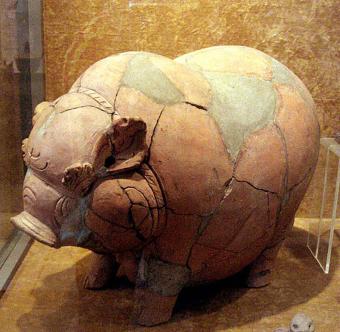
Whether your favorite historic example is a rare Wade Paws at the Kerb, a Roseville Razor Back, or one of the thousands of marked and unmarked vintage and antique piggy banks, these highly desired collectibles are sure to bring a smile to the lips of collectors, both young and old, because of the way that they harken back to a childhood where getting a quarter felt like winning the lottery.
How the Piggy Bank Came to Be
The exact origin of the piggy bank is shrouded in mystery and folktales, though historians speculate that the piggy bank concept dates back to as far as the mid-16th century. During this period, many dinnerware and storage vessels were crafted from an inexpensive orange clay called pygg, and pygg jars that held spare change could be found in many households across western Europe. Soon, this money-saving routine became a tradition, and the name inspired puny English potters to mold these money-saving vessels in the image of the animal itself. As industrialization increased families' spending money, more and more children were being gifted these piggy banks. However, early examples were not built with an exit-hole, meaning they had to be destroyed in order to get the money at the end; this was adjusted in the 20th century, with cheap plastic piggy banks still being sold to this day.

Types of Antique Piggy Banks
Interestingly, coin banks, of which piggy banks are a stylistic subset, can be divided into two separate categories: still banks and mechanical banks. Still banks describe coin banks which have no moving parts and just act as a receptacle for change, and most piggy banks fall into this category. Meanwhile, mechanical banks were first developed by the J & E Stevens Company in 1869 and they describe coin banks which register the weight of a coin, activating its mechanism to ingest the money.
Identifying Antique and Vintage Piggy Banks
Piggy banks are one of the easiest collectibles to identify because they hold such an iconic, and universally known, shape. Earlier examples of piggy banks normally feature a more anatomically accurate depiction of the pig, whereas more contemporary versions highlight a cutesy, stylized version of the beloved farm animal. Of course, if you want to broaden your definition of piggy bank, there's an endless number of shapes that you can find. However, there is a basic form that all piggy banks share:
- Coin slot - A piggy bank of any kind has to have a coin slot; these slots can be small enough to only fit a single coin or large enough to fit wads of cash.
- Stopper/Plug - Many piggy banks have a stopper or plug covering a separate hole which owners could use to retrieve their money from, but antique examples usually won't.

Materials Used to Make Antique Piggy Banks
Antique piggy banks were crafted out a variety of different materials, some of which include:
- Clay
- Porcelain
- Plaster
- Cast iron
Antique Piggy Bank Manufacturers
Given the popularity of piggy banks during the late 19th century and early 20th centuries, it's difficult to compile an exhaustive list of notable manufacturers. Yet, here is just a taste of the different maker's that might have created your grandmother's piggy bank.
- Quimper
- Arthur Wood
- Sadler
- Wade
- Goebel
- Ellgreave
- Szeiler
- Plichta
- Masons
- Lefton
- McCoy
- Hull
- Franciscan
- Shawnee
Evaluating Antique Piggy Banks
The most collectible piggy banks come from the late 19th century and early 20th century and often feature that quintessentially rotund pig shape with a stopper on the bottom. Things that can increase an antique piggy bank's worth include having the original stopper and plug intact if the piggy bank has a hole for one, the piggy bank itself fully intact, and examples generally withstanding the wear and tear of aging.

Antique Piggy Banks Costs
You'll find that antique piggy banks are relatively inexpensive, costing anywhere between $25-$200, though the most common varieties available on the market are vintage examples. For instance, this vintage American cast iron piggy bank is listed for about $275 in one online auction, and this 1957 Hull Corky piggy bank with the original cork intact is listed for only $40 in another auction. If you're really interested in finding an antique piggy bank, that's still intact, you're going to have to be a bit patient in your search for one. However, once you find that perfect example, chances are it'll be cheap enough for you to immediately purchase.
Save Your Money in Style
No matter what your penny pinching for - a new house, student loans, a new car, a massive garden, and so on - getting yourself an antique piggy bank will you let save your money in style. Harken back to your childhood days, where every quarter felt like it'd unlock your wildest dreams and put that piggy bank to good use. Who uses change these days anyway? By the time your piggy bank is ready to burst, you just might have saved enough for that other cool antique that you need in your life.







